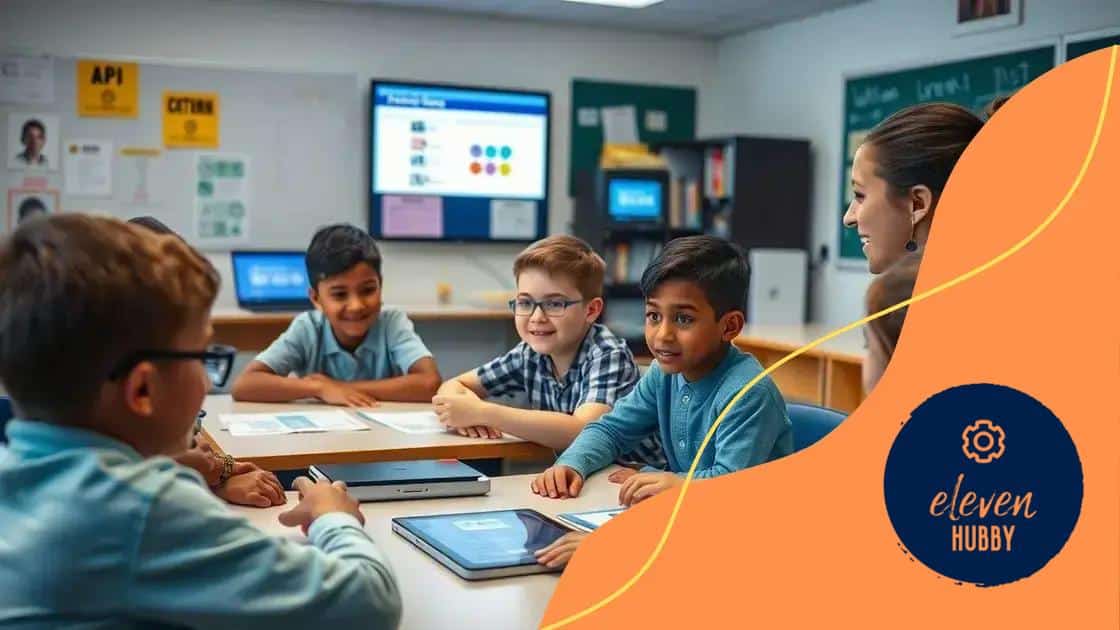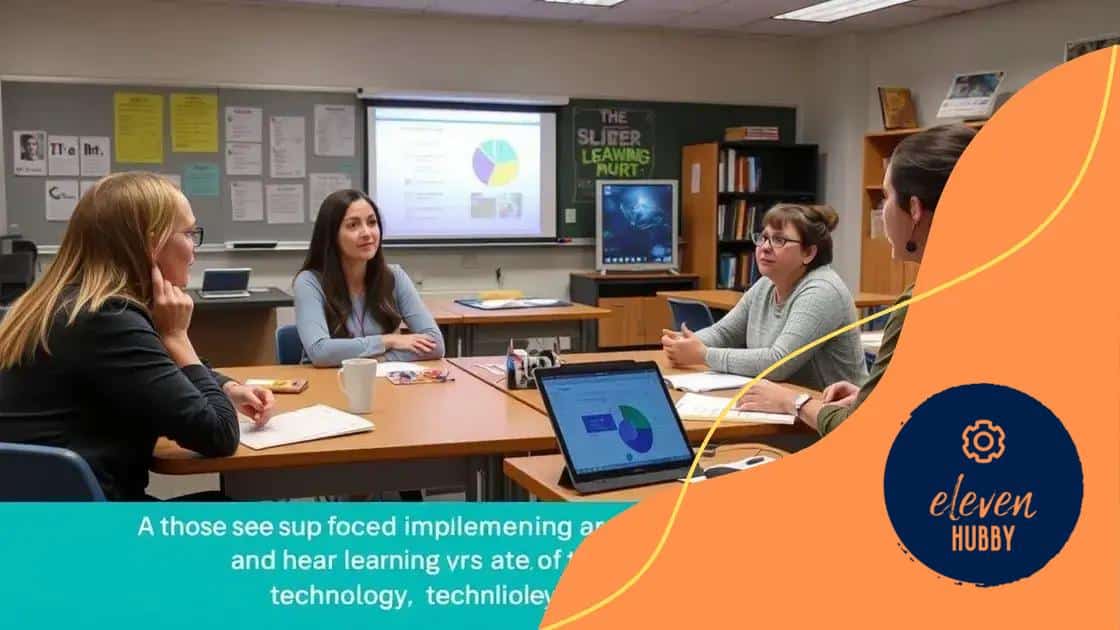The impact of AI in personalized learning pathways

The impact of AI in personalized learning pathways allows for customized educational experiences by analyzing student data and adapting content, enhancing engagement and effectiveness in diverse learning environments.
The impact of AI in personalized learning pathways is reshaping how students learn and engage with educational content. Have you ever considered how technology can tailor lessons just for you? Let’s dive into this transformative trend.
Understanding AI and personalized learning
Understanding AI and personalized learning is essential in today’s educational landscape. Artificial Intelligence transforms the way educators can tailor experiences for each student, paving the way for a more effective learning journey.
What is AI?
At its core, AI refers to the ability of machines to perform tasks that typically require human intelligence. This includes learning, reasoning, problem-solving, and even understanding language. In education, AI can analyze student performance in real time, allowing for tailored learning experiences.
Personalized Learning Defined
Personalized learning is an educational approach that aims to customize learning for each individual student. This method recognizes that students have different strengths, weaknesses, and preferences when it comes to learning. By leveraging AI, educators can create lessons that fit the unique needs of each student.
How AI Enhances Personalized Learning
Here are some ways AI plays a vital role:
- Data analysis: AI can collect and analyze data on student performance, identifying areas where they excel or struggle.
- Adaptive learning: AI-driven platforms adjust the difficulty of tasks in real time based on student interaction.
- Engagement: Interactive AI tools, like chatbots or learning apps, can keep students engaged and motivated.
Moreover, AI encourages a more adaptive curriculum. For instance, if a student struggles with math, the system can recommend extra practice in that area while allowing them to progress in subjects where they excel. This ensures that no student is left behind.
Another feature is the ability of AI to provide immediate feedback. Unlike traditional methods, which may delay feedback until assignments are graded, AI can give insights as students work through problems. This helps them understand their mistakes in the moment and learn more effectively.
As the educational sector continues to evolve, understanding how AI integrates with personalized learning will only become more crucial. It empowers students to take control of their learning journey, fostering an environment where everyone can succeed.
Benefits of AI in customizing learning experiences
Understanding the benefits of AI in customizing learning experiences is essential for educators and students alike. AI technologies offer unique opportunities to enhance teaching methods, making learning more engaging and effective.
Personalized Learning Paths
One of the greatest advantages of AI is its ability to create personalized learning paths. By analyzing individual student data, AI can identify strengths and weaknesses, allowing for a tailored educational experience.
- Adaptive Content: AI can adjust the difficulty of learning materials to match student proficiency.
- Learning Preferences: It accommodates different learning styles, whether visual, auditory, or kinesthetic.
- Real-Time Feedback: Students receive immediate feedback, helping them understand mistakes instantly.
Furthermore, these personalized paths keep students motivated. When learners see progress tailored to their unique skills and interests, they are more likely to stay engaged in their studies.
Enhanced Engagement Techniques
Another benefit is the use of enhanced engagement techniques. AI tools can incorporate gamified learning experiences, making lessons feel more like interactive games rather than traditional assignments. Through this approach, students develop a better connection with the material.
Additionally, AI can facilitate collaborative learning environments by connecting students with peers who have similar goals or interests. This not only enriches the learning experience but also fosters essential social skills.
Improved Administrative Efficiency
Beyond students, AI benefits educators by streamlining administrative tasks. Teachers can spend less time on grading and more time interacting with students. AI can analyze assignments automatically, providing instant results which allows educators to focus on teaching rather than administrative duties.
With the aid of AI, personalized learning experiences become more accessible, allowing every student to thrive according to their potential. AI technologies bridge the gap between individual learning requirements and effective teaching strategies effectively.
Challenges faced in AI implementation

Implementing AI in educational settings comes with its own set of challenges. While the potential benefits are significant, navigating the obstacles is crucial for successful integration.
Technical Limitations
One major challenge is the technical limitations of AI systems. Many schools may not have the necessary infrastructure or resources to support advanced AI technologies.
- Insufficient hardware: AI tools require powerful computers and software that may be beyond the budget of some institutions.
- Low internet connectivity: Consistent and fast internet access is essential for AI tools to work effectively.
- Data security risks: Protecting sensitive student information is a top concern, and inadequate measures can lead to breaches.
Another hurdle involves the lack of training for educators. Many teachers may not be familiar with how to use AI tools effectively, making it difficult for them to integrate technology into their teaching.
Resistance to Change
Resistance to change is another significant barrier. Some educators and institutions may hesitate to adopt new technologies due to fear of the unknown or skepticism about their efficacy.
Additionally, there can be a lack of understanding about how AI enhances the learning experience. When teachers or administrators do not recognize the potential benefits, they may be less likely to embrace these changes.
Cost Implications
Cost implications also play a critical role in the decision-making process. Implementing AI can require substantial investment, from purchasing software tools to ongoing maintenance and support.
- Initial investment: Schools must allocate funds for software licensing, hardware upgrades, and training.
- Ongoing costs: Maintaining AI systems often includes subscription fees and technical support.
- Budget constraints: Many educational institutions operate under tight budgets, making it difficult to justify these expenses.
Despite these challenges, understanding and addressing them is key to successfully implementing AI technologies in education. Overcoming these hurdles can lead to a more innovative and effective learning environment for all students.
Case studies of successful AI in education
Case studies of successful AI in education highlight how technology can transform learning environments. These examples demonstrate the practical benefits of integrating AI into the classroom.
AI in Personalized Learning
One notable case is the use of AI at Carnegie Learning, where adaptive learning software tailors math instruction to individual student needs. By analyzing performance data, it adjusts the difficulty level, helping students grasp concepts at their own pace.
- Results: Schools using this AI tool reported increased student engagement and improved test scores.
- Customization: The software modifies lessons based on each student’s progress and challenges, making learning more effective.
This case illustrates the power of personalized learning through AI, as it caters to diverse learning styles and abilities.
AI in Enhancing Teacher Support
Another successful implementation of AI is seen in the TeachFX platform, which analyzes classroom discussions. By providing feedback on questions posed by teachers, it helps educators improve their questioning techniques.
The platform uses voice recognition technology to evaluate interactions in real-time. This data allows teachers to refine their communication, encouraging more student participation.
- Impact: Teachers using TeachFX noted a marked increase in classroom dialogue and student engagement.
- Professional Development: This AI tool also supports ongoing teacher training, fostering a culture of growth.
Such examples reveal how AI can enhance teacher effectiveness, creating a more positive learning atmosphere.
AI in Reducing Dropout Rates
Furthermore, the use of AI at Georgia State University helped to significantly reduce dropout rates. The university employed an AI chatbot named Pounce that assists students with enrollment and academic advising.
Pounce engages students through text messaging, answering questions and providing reminders about deadlines. This proactive approach keeps students informed and connected to the campus community.
- Success Rate: Following the chatbot implementation, the university reported a drop in the freshman dropout rate by around 20%.
- Accessibility: Pounce provides support 24/7, ensuring students can access help whenever they need it.
These case studies show that successful AI integration in education not only enhances learning but also addresses critical issues like dropout rates and teacher support.
Future trends of AI in personalized learning pathways
The future trends of AI in personalized learning pathways promise to reshape education in exciting and innovative ways. As technology evolves, so do the methods and tools that can enhance learning experiences for students.
Increased Adoption of Adaptive Learning Technologies
One significant trend is the increased adoption of adaptive learning technologies. These systems adjust content based on a learner’s pace and understanding, creating a truly personalized experience.
- Real-time data analysis: AI will increasingly use data analytics to track student performance continuously, adapting lessons accordingly.
- Enhanced interface: Future platforms will offer more user-friendly interfaces, making it easier for students to interact and engage with learning materials.
- Broader subject coverage: Expect a rise in AI solutions that cover a wider range of subjects, including art and social sciences, not just STEM.
This shift towards adaptive learning will empower students to take control of their educational paths, allowing for mastery of topics at their own speed.
Integration of Virtual and Augmented Reality
Another exciting development involves the integration of virtual reality (VR) and augmented reality (AR) into personalized learning. These technologies will offer immersive experiences that enhance understanding and retention.
For example, students could explore historical sites in VR or conduct science experiments in a safe AR environment. This hands-on learning will be especially beneficial for visual and kinesthetic learners.
AI-Driven Analytics for Educators
AI-driven analytics will also become more prevalent, providing educators with in-depth insights into student progress and behavior. This data can guide teaching strategies and interventions.
- Predictive analytics: Educators can anticipate student challenges and adjust their teaching methods accordingly.
- Customized feedback: AI tools will facilitate timely feedback for students, helping them understand their achievements and areas for improvement.
- Collaborative platforms: Future AI solutions will promote collaboration between students and teachers, fostering a community of support.
By leveraging this data, teachers can create targeted lesson plans that address the needs of each student, improving overall educational outcomes.
As we move forward, the future of AI in personalized learning pathways looks promising. With ongoing advancements, education can become more engaging, inclusive, and effective for all learners.
FAQ – Frequently Asked Questions about AI in Personalized Learning Pathways
How does AI enhance personalized learning?
AI enhances personalized learning by analyzing individual student data and adapting educational content to meet their unique needs and learning styles.
What challenges do schools face in implementing AI?
Schools face challenges like technical limitations, resistance to change, and budget constraints when trying to implement AI solutions.
Can AI help improve student engagement?
Yes, AI can improve student engagement by providing interactive learning experiences and real-time feedback, making lessons more engaging.
What trends can we expect in AI-enhanced education?
Future trends include increased adoption of adaptive learning technologies, integration of VR and AR, and use of AI-driven analytics for better teaching strategies.
 Personalized Learning
Personalized Learning Tech Integration
Tech Integration Data Insights
Data Insights Accessibility
Accessibility Future Ready
Future Ready





